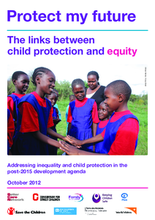The lack of care and protection facing children is a global crisis. Every year up to 1.5 billion children are estimated to experience violence; 150 million girls and 73 million boys are raped or subject to sexual violence; more than half of the 215 million child laborers are doing hazardous work. Many children experience sexual, physical and emotional abuse, violence, and neglect in their own homes, and growing numbers fend for themselves on the streets or in child-headed households, or are poorly cared for in large institutions.
This paper looks at the relationship between this lack of care and protection and inequality. It explores how inadequate care and protection produces and contributes to inequalities and how inequality is itself a cause of inadequate care and protection. The paper also examines the long-lasting impact of inadequate care and protection which greatly affects children’s life chances into adulthood, suggesting that inadequate care and protection is in itself a form of inequity. In order to break the spiral of disadvantage, the report recommends a three-pronged strategy:
- Reductions in social and economic inequalities that have a major impact on children’s care and protection
- Increased investments in strong and equitable national child protection systems
- Efforts to address the stigma and discrimination faced by children without adequate care and protection
Thus, a new focus on the care and protection of children is required if global development goals are to stand a chance of being met. The paper is much needed because although the effects of some forms of inequality on children have been highlighted by research, the links between child protection and inequality have received scant attention.
This paper is part of an inter-agency series on the links between child protection and major development goals. Other papers in the series address subjects including health, education, population dynamics, climate change and conflict, and growth. This series is contributing to a global inter-agency campaign to raise the profile of child protection and care in development and humanitarian goals, including the framework that will replace the Millennium Development Goals (MDG) when they come to an end in 2015.
©Family for Every Child on behalf of Better Care Network, Consortium for Street Children, Keeping Children Safe, Plan, Save the Children, Sos Children's Villages, Terre des Hommes International Federation, and World Vision

